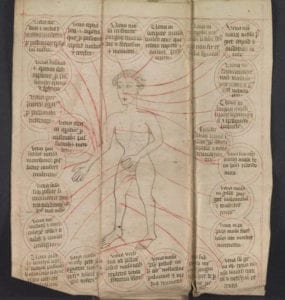Erin Connelly
Philadelphia, Pennsylvania, United States
 |
| “Urine Wheel,” Almanack, Free Library of Philadelphia – The Rosenbach, MS 1004/29, fol. 9 C (York, England, 1364), courtesy of Bibliotheca Philadelphiensis. OPenn Repository |
Great disparities in wealth and differences in access to healthcare between the top and bottom of society are hardly new experiences in human history.1-4 Even before the Hippocratic Oath was standardized, there were various versions of professional codes of ethics and behavior toward the financial status of patients among medical practitioners. Many medieval medical texts set out the desired character traits of a good medical practitioner, especially as pertains to surgeons, with instructions on how to navigate payment depending on the patient’s situation. In a chapter on the qualities and etiquette expected of a surgeon, a Middle English translation of a text by Lanfranco of Milan advises the surgeon to “help the poor as much as possible and seek proper payment from wealthy patients.”5 This concept is echoed in the writings of the influential medieval French surgeon, Henri de Mondeville: “I repeat that the surgeon ought to charge the rich as much as possible and to get all he can out of them, provided that he does all he can to cure the poor.”6 A fifteenth-century Middle English translation of John Arderne (of Nottinghamshire) contains a lengthy opening statement about the key character traits of a good surgeon, including honesty, cleanliness, sobriety, charity to the poor, a good relationship with colleagues, and confidentiality.7 Composed just beyond the medieval period in 1566, the laws and ordinances developed by the London Company of Barber-Surgeons ordered that members “shall go to the poor as well as to the rich.”8 Concern for the medical needs of the poor is one of the main virtues for medical practitioners described in these early texts. However, in both historical and modern practice it is one matter to pronounce an oath to patient care in light of financial burdens, and another matter to deliver on those commitments when it comes to the complexities of medical treatments. Using the Middle English medical text Lylye of Medicynes as a starting point, it is possible to begin to build a picture of differences in recommended treatment plans based on a patient’s financial situation. In the Lylye, differences in treatment for the rich and the poor are mentioned more frequently than differences in treating men and women or in treating children and adults.
The Lylye of Medicynes is a significant fifteenth-century Middle English translation of a Latin medical text, the Lilium Medicinae, which was written in the early fourteenth century by Bernard of Gordon, a highly-respected medical doctor and lecturer in the medical school of Montpellier. His works were translated into multiple languages, included on the curriculums of medical schools throughout the medieval period, and appear in printed editions well into the early modern period. The Middle English Lylye contains hundreds of remedies, arranged in seven books, for diseases of the entire body and mind.
 |
| “Phlebotomy Diagram,” Almanack, Free Library of Philadelphia – The Rosenbach, MS 1004/29, fol. 8 D (York, England, 1364), courtesy of Bibliotheca Philadelphiensis |
Different treatments are not provided for every illness, but those in which differences are noted can be summarized into two categories: 1. chronic conditions, and 2. diseases associated with poverty. It is not surprising that differences in treatment are mentioned for chronic conditions, such as epilepsy and leprosy, where the ability to afford long-term treatment becomes problematic for a low-income person. Furthermore, these chronic conditions were considered next to impossible to cure and difficult to treat, except by using a diverse plan of remedies and ingredients. A rich person was provided with a wide range of options and expensive medications. For instance, in the case of leprosy (or various skin conditions with the characteristics of leprosy), a rich person was offered electuaries made with pearls (diamarciaton) or ambergris (diambre), while a poor person received electuaries made with rosemary (dianthos) or aloes (dianisum).9 The valuable ambergris again was a recommended treatment for a rich person suffering from stomach pain/vomiting, while a poor person was limited to standard, readily available ingredients, such as mint.10
Coughing and lice were conditions associated with poverty. In the case of coughing, the Lylye states: “poor men are much afflicted with this condition.”11 For lice, the text says that it is a condition of poverty (or the result of a religious vow) and provides remedies without ever mentioning wealthy counterparts.12 Many of the available medieval medicines seem to be beyond the reach of the poor. For instance, to cure coughing in a poor person, the text suggests breath control exercises, such as: “let him hold his breath often as much as it is possible” or “blow the fire often.”13 These treatments were surely affordable, but perhaps not all that effective in treating the condition.
The differences in treatment reviewed here from a select medieval text largely have to do with accessibility to ingredient choice. To reflect back on the words of the medieval surgeons Lanfrank and De Mondeville, who advised practitioners to ensure receipt of payment from wealthy patients (even as means to recover losses from cases of charity), it does raise the question about ingredient efficacy and considerations of expense. For instance, in the case of stomach pain given as an example above, perhaps the infusion of mint recommended for the poor person may be enough to settle an upset stomach over the expensive ambergris recommended for the rich person suffering from the same condition. This also raises questions about the potential advantage of a placebo effect from receiving a fancy, expensive medicine, as opposed to a common plant. As well as the great advantage for a wealthy person of having access to a physician’s time and full arsenal of cures, especially in the case of a chronic condition. Is there an analogy or even an answer to be found in these medieval pages for current disparities in access to healthcare? The medieval physician’s voice of the Lylye of Medicynes, and other medical texts, makes it clear that treatments often are not straightforward. However, perhaps the historical advice for treating the afflicted poor is as true today as it was in medieval times: “the cure may be by changing of his life.”14
Endnotes
- Diego Alejo Vázquez Pimentel, Iñigo Macías Aymar, and Max Lawson, Reward Work, Not Wealth (Oxford: Oxfam GB, 2018), 2, DOI: 10.21201/2017.1350
- Steffie Woolhandler and David U. Himmelstein, “The Relationship of Health Insurance and Mortality: Is Lack of Insurance Deadly?” Annals of Internal Medicine, 167, no. 6 (June 2017): 424-431, DOI: 10.7326/M17-1403
- Karen Dunnell, Colin Blakemore, Steven Haberman, Klim McPherson, and John Pattison, Life Expectancy: Is the Socio-Economic Gap Narrowing? (Longevity Science Panel, February 2018), https://www.longevitypanel.co.uk/_files/LSP_Report.pdf
- “A Modern Hippocratic Oath by Dr. Louis Lasagna,” Association of American Physicians and Surgeons, Inc., http://www.aapsonline.org/ethics/oaths.htm
- “pore men helpe he be hys myght, & of ryche men seke he gode rewarde” in Lanfranco of Milan, Lanfrank’s Science of Chirurgie, ed. Robert von Fleischhacker (EETS O.S. 102, 1894; Reprint, Millwood, N.Y.: Kraus, 1973), 9; the translation is my own
- Quoted in: John Arderne, Treatises of Fistula in Ano, Haemorrhoids, and Clysters by John Arderne from an Early Fifteenth-Century Manuscript Translation, ed. D’Arcy Power (London: EETS O.S. 139, 1910), xxiv
- Arderne, Fistula in Ano, 4-8
- Sidney Young, Annals of the Barber-Surgeons of London (London: Blades, East & Blades, 1890), 182
- Lylye of Medicynes, Oxford Bodleian Library, MS Ashmole 1505, fol. 32r; the Modern English translations and edited Middle English quotes are my own
- Lylye, fol. 203v
- “pore men havyþ myche þis pascioun,” Lylye, fol. 144v
- Lylye, fol. 56v
- “lete hym holde ofte his breþe as myche as it is possible” or “blowe þe fuyre ofte,” Lylye, fol. 144r
- “þe cure herof may be by chaungynge of hys lyf,” Lylye, fol. 56v
ERIN CONNELLY, PhD, is a former CLIR-Mellon Postdoctoral Fellow for Data Curation in Medieval Studies in the Schoenberg Institute for Manuscript Studies, University of Pennsylvania Libraries. She has a special interest in medieval medical texts and the relevance of medieval medicine for modern infections (ancientbiotics). Her doctoral project was the first edition of the fifteenth-century Middle English translation of Bernard of Gordon’s Lilium medicinae, the Lylye of Medicynes. She collaborates on a wide range of interdisciplinary projects
Highlighted in Frontispiece Volume 12, Issue 1 – Winter 2020
Spring 2019 | Sections | History Essays

Leave a Reply